
Livestock
In the 1930s the area of the project was part of a large sheep station, one of many in the region:

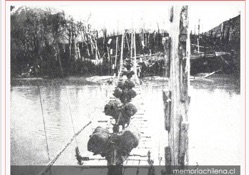
Hauling wool, Aysén
After the burning of the ancient forest in the valley in 1939 cattle was introduced, with some sheep remaining. Cattle accelerated soil degradation and prevented the natural vegetation regrowth.
Cows have been so far a serious problem for the project, cows are more damaging than sheep.
The main regret the project has in its operation is allowing one of the local staff running some cows for a while.
Removal of the grazing pressure was a real turning point in and a boost to
the rebound of the ecosystem and natural regeneration.
Cattle pose risk for the wildlife in the region, for example transmitting deadly diseases to endangered national symbol - huemul, which is returning to the Project as the ecosystem restores.
It has been attested that cattle is main danger for huemules in the region, probably after stray dogs in natural areas :
Huemules are dying in Aysen ; in 2020 as well.
Posible presencia de enfermedad en huemules del Parque Nacional Torres del Paine.pdf
Removing cattle from the hills and the valley floor was the turning point in the revitalisation of the land. Trees started growing and the vegetation cover resumed quickly.
Cows have been the most damaging factor for the project since it’s start. The major mistake made was allowing the local worker, using local cattle management practices, to keep some cows for several years, the number of which was seldom as small as agreed. Cows have memories and an internal compass, they can come back from long distances to feeding areas.
At present cattle from neighbouring properties and State (fiscal) land still pose problems for the Project, as well as their extensive presence in the adjoining Laguna San Rafael national park:
-
-Penetrate into the project crossing the rivers when these are low, triggering the building of unnecessary fences.
-
-Soil has virtually no microbiota - cow dungs do not decay for decades. This is reinforced by the use of anti-parasites such as ivermectin and other.
-
-Cattle is far more damaging for prairies areas than the native herbivores.
Rather recent, introduced by colonisation of the last century, practices of cattle management and local livestock management culture have been fatal for the land, already destroyed by clearing fires:
The first and major issue has been overgrazing, common equally to sheep and cows (see below the situation in the region with sheep overgrazing).
In the project area: grass does not grow under Nothofagus trees, main native tree genus. Cows eat young trees and soft plants instead and destroy their eating areas. Previously all human activities were concentrated in the valley, cattle were grazing the uphill sensitive areas.
The dominant, imposed 70 years ago, management style of cattle allowed cows moving freely anywhere, resulted in acceleration of erosion on the hills of the valley:
The soil is fragile, cows break the soil crust and eat vegetation ➜ erosion.
In wetlands: they compress the soil, mainly sphagnum, form channels, the wetland erodes and does not reestablish itself.
Unlike sheep, cows move following each other and have large solid hooves, creating erosive paths.
Cows have memories - they always return to the areas of good food, in case of local culture of free range cattle management it is destructive for the land.
Due to little ecological memory in insects after fire, native insects and soil life did not recover after the clearing fires of the last century, no new insects neither life in soil re-colonised the area ➜ nothing grows under cow dungs as there are not insects or worms decaying them into soil. For 25 cows approx. a hectare of soil is lost per year under dungs by a farmer.
Due to low quality of food (destroyed ecosystem) one cow requires at least 5 ha for grazing in the region, it makes it difficult to monitor their move in the wilderness:
Cows are efficient in spreading invasive species (rosa mosqueta, chapel, calafate, etc.).
Cows love the fruit of the very invasive rosa mosqueta and helped significantly to disperse it, allowing its invasion of large areas, cleared from natural indigenous regrowth by the same cattle which was moving on the hills unrestricted. Where cows were grazing mosqueta is present, it does not follow sheep.
Local cattle management:
Bulls are left all time with cows, as a result calfs are born all year around, cows
die often in birth, unattended. As the husbandry is heavily subsidised on the
local level, these deaths are ignored by gaucho farmers.
Cows are free and spread in the wilderness, looking for cows involves dogs
and therefore harassment and destruction of wildlife. Stray dogs are becoming
a real problem for native wildlife in the area.
Freedom of cows exposes them to predators like pumas and exacerbates
the human-predator conflict for pumas and native foxes.
Intensive grazing could have been the solution, but is not locally accepted so far.
Also organic solutions like planting tansy for parasite control, etc.
A good assessment of the overgrazing issue in the region by Conservacion Patagonica (now Tomkins Conservation),
published on the website of the organisation in 2018:
Sheep: “As livestock strips an area down to minimal vegetation, a downward spiral begins. Sheep are selective grazers and long-standing irresponsibility in management has intensified grazing patterns of uneven utilization. This inequity in grazing can lead to animal distribution levels that vary from 8 to 20 times the total stocking rate of a given pasture. This grazing pattern makes it virtually impossible for certain plants to recover. More and more woody, unpalatable plants dominate the landscape as livestock selectively eat grasses and not these scrubs, rendering the land less productive for both livestock and wildlife.
Damaged grasslands retain less moisture, continuing to break up ground cover and further inhibiting the re-growth of native, perennial plants that are more capable of absorbing carbon dioxide and enriching soil. Meanwhile, diminishing vegetation cover leaves sandy soils vulnerable to wind erosion from Patagonia's notoriously fierce winds. Like in regions of Africa bordering the Sahara, vast areas of Patagonia have already turned to desert, virtual dead zones for flora and fauna.
These ecologically damaging practices have proven economically unsustainable as well. Although drastically lower stocking rates might make sheep ranching ecologically responsible, such a system would not be economically viable in much of the region given its remoteness, severe climate and the relatively low global price of meat and wool. The Patagonian sheep industry, which began less than a century ago, peaked in 1952, with over 21 million sheep in the region. Since then, the livestock industry has contracted; by 1999, only 8.5 million sheep remained in the region. Competition on the world wool market from Australia combined with ecological decline from overshooting the carrying capacity of the land to make raising livestock a poor economic base for the region. Many historic estancias have been abandoned as desertification has rendered them economically unviable.
Severe desertification affects ~30 % of the region. Even worse, over 90 % of Patagonia suffers from some degree of degraded soils, mostly because of unsustainable land use exacerbated by natural forces of erosion. Studies have found that in no area of Patagonia have the impacts from grazing been negligible. Throughout Chile and Argentina, the desertification of Patagonia is widely recognized as one of the most urgent ecological problems. Government ministries in Chile and Argentina confirm that overgrazing must end to avoid further—often irreversible—damages.”

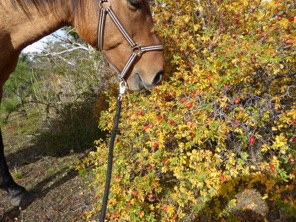
Introduced species love
mosqueta fruit.
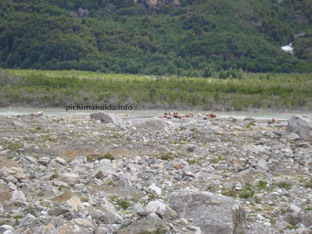
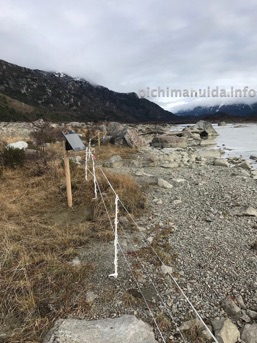
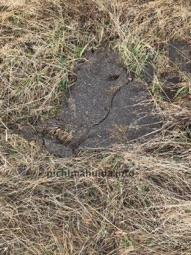
Very old cow dung, does not degrade
Cows crossed Leones river into a sensitive area of the project
Electric cow fence; implementation of “fence ecology”.

Mosqueta-stricken side of a road used for moving cows

Cow farts produce a lot of methane (28 times more potent than CO2),
a big contribution to climate change on global level. 55% of the greenhouse gas emitted by agriculture comes from livestock.
The ancient forest of the region was annihilated mainly for the sake of cattle grazing =
for meat consumption
(analogy to Amazon fires of the last years)
The project is now a cow-free and sheep-free zone
Unfortunately for the cattle of the region it is suffering badly from globalisation: its live export to China is developing. It involves months of travel on a ship in cruel nightmare conditions, resulting in the extreme suffering and deaths of the animals.
EU - Mercosur agreement:
Every 3 minutes the EU imports 1 football pitch of deforestation from the Mercosur bloc, mainly due to beef and soy imports.
